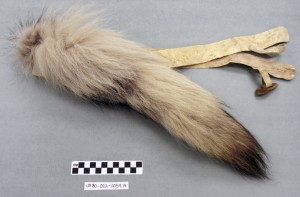d. Wolf Tail Belts

, Inupiaq wolf tail belt and wolf nose headdress, 1900 – 1980, Barrow, Alaska, wolf tail, caribou skin, ivory, glass beads, cotton thread; Image courtesy of the University of Alaska Museum of the North.
–Sarah Diver
Wolf Tail Belt and Wolf’s Nose Headband
Pictured above (Figure 6) is a wolf’s tail belt from the mid-twentieth century. About 19” inches long, this wolf’s tail belt is made by sewing a wolf’s tail to 1 ½ inch strip of sun-bleached caribou skin, and an ivory carving of a whale head is used as a button to fasten the belt around the wearer’s waist.[1] Accompanying the wolf tail belt is a wolf nose headband, decorated with red, white, and blue beads and reinforced with caribou skin.
In 2003, Inupiaq community member, Herman Ahsoak of Barrow, commented on these objects from the University of Alaska Museum of the North Museum’s collection:
“I believe this Head Gear was used in Dancing to represent the animals that were the first to learn how to sing and dance from the Eagle Mothers first Student. In other words when the Eagle Mother took her first student to teach him how to sing and beat a drum, the Students first contact was the animals. He taught the animals how to sing and dance, because they were transformed to human form by the Eagle Mother.”
Herman Ahsoak recalls the story surrounding of the Eagle-Wolf dance when observing these objects. Keeping the unique features of the wolf intact, this headband and belt are perhaps modern versions of the wolf head mask and wolf’s tail belt from the late 19th century Eagle-Wolf Dance as part of the Messenger Feast. We further understand the significance of specifically wolf fur in the context of hunting practices. It required great tracking skill and ingenuity to hunt wolves, which were primarily acquired for their highly prized fur.[2] Because there were numerous taboos associated with hunting and processing wolves, wearing the wolf’s tail as a belt was likely a form of wearing an amulet.[3] Often aligning the wearer with the particular qualities of the animal’s body, amulets served many purposes, including improving physical strength and agility, heightening the senses, or sometimes increasing fertility.[4] Wearing a wolf’s tail in a ceremonial context, subsequently, would have allowed for multiple simultaneous meanings: the wearers could honor the wolf’s inua by wearing his beautiful fur, the wearers could receive special wolf-like powers from wearing a part of the wolf’s body as an amulet, the wearer could represent or act out the part of the wolf from the Eagle-Wolf story underlying the performed dance, and finally, the wearer could showcase his particular talent for hunting wolves, as only the person who killed a wolf could wear its fur.[5]
Wolf’s Tails and Masks in Avery Properties Drawings
Wolf imagery plays a prominent role in many of the Avery Properties drawings. In Drawing H, for example, the four men at the right end of the line have wolf’s heads for hoods on their parkas. These wolves’ heads likely speak to the ability of those men as hunters and endow them with certain wolf qualities. Though it is unclear whether these figures are specific individuals or this is a transformative image, we can guess that the men depicted are representative of people who would have been highly respected within the community, given that wolves were such highly valued and special animals. In Drawing D, the wolf’s head masks subsume all of the human facial features of the dancers, emphasizing the transformational story behind the Eagle-Wolf dance. Here, the actual use of real wolf’s head would have held special meaning for the dancers, given the importance of wolf’s fur and body parts in Inupiaq culture. Finally, in Drawing J, the men play a game with wolf’s tail belts attached to a few of their waists. This was perhaps one way of both gaining special physical power during an athletic event and designating who was on whose team (see Inupiaq Games).
[1] “Headdress, Wolf and Belt.” University of Alaska Museum of the North. http://arctos.database.museum/guid/UAM:EH:UA80-022-0059AB.
[2] Burch, Ernest S. “The Economic Process.” Chap. 4 In Social Life in Northwest Alaska : The Structure of iñUpiaq Eskimo Nations, 176. Fairbanks: University of Alaska Press, 2006.
[3] Ibid.
[4] Oosten, Jarich. “Amulets, Shamanic Clothing, and Paraphernalia.” Chap. 4 In Braving the Cold: Continuity and Change in Arctic Clothing, edited by Buijs and Jarich Oosten Cunera, 106-07. Leiden, The Netherlands: CNWS Publications, 1997.
[5] Burch, Ernest S. “The Economic Process.” Chap. 4 In Social Life in Northwest Alaska : The Structure of iñUpiaq Eskimo Nations, 176. Fairbanks: University of Alaska Press, 2006.
Leave a Reply
You must be logged in to post a comment.